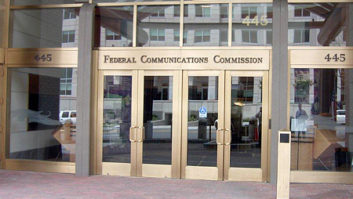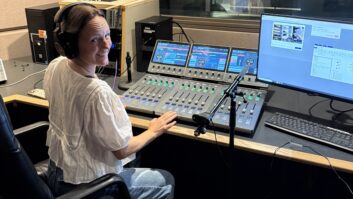It seems obligatory to reflect on the year past and extrapolate industry trends while peering ahead to make predictions for the coming year. Our industry has been grappling with critical issues that will influence what we’ll be doing as broadcast professionals in the near future.
Let’s take a closer look. What does your intrepid masked soldering soldier of radio see happening as the year unfolds?
ADOPTION OF HD TRANSMISSION STANDARDS
Sometime during the year, probably after the commission deals with media ownership limits and other less controversial issues, we should finally see the long-awaited Ibiquity HD transmission standards written into the rules.
The FM HD service will continue to grow and add HD2 channels at an impressive pace. While most HD2 stations will be fully automated offerings, unique live programming will appear on a few trailblazing, standalone HD2 pioneers like WHUR-HD2 in Washington.
Proactive radio companies will be enlisting help from partners like Microsoft and Cisco, looking to harness all they can from HD. Witness Clear Channel’s recent partnership with Microsoft to develop new HD text and data opportunities.
The nighttime prohibition of AM HD operations will be lifted, with the caveat that interference complaints be appropriately handled. I don’t see a rapid increase in the number of new AM HD operations during the year as existing HD stations go full-time and deal with the first wave of complaints. The majority will come from listeners outside protected contours and DXers, in addition to station licensees and their operatives.
The industry will be watching closely but the aftermath will reveal a more muted response to interference than many had been expecting — a bit of a wake-up call that AM radio listening at night is not a topic of concern for most listeners. Those who remain are simply too used to interference, and tolerate it.
The sad reality is that many stations will lose much of the bonus fringe area coverage they’ve enjoyed during the analog era as HD adoption accelerates. The commission will only grant relief to qualifying “real” interference so the AM service will mostly lose whatever is left of previously established expanded coverage.
Digital Radio Mondiale could provide some mitigation to the shortcomings of the AM HD design but Ibiquity will not be moved to change its standard without sufficient pressure from the industry to consider an improved AM digital solution.
I’m not hopeful improvements to AM HD will happen in 2007 or the foreseeable future. Full-time AM HD will roll out slowly amid mixed complaints about interference primarily because the owners of most of the significant AM properties have resigned themselves to accept the new interference in exchange for the opportunity to go digital with hi-fi stereo.
AM stations gradually will shift resources to developing their Internet presence as much or more than deployment of HD, if they choose to add it. Many will place their AM programming on a sister FM HD2 channel as added insurance.
AM IMPROVEMENT, ANYONE?
We can only hope the commission will move quickly this year to approve the NAB’s proposal to allow FM translators on AM. This will allow many stations crippled with interference problems and marginal nighttime coverage their first real opportunity to provide better service. Daytimers will finally gain at least some measure of full-time status.
Unfortunately I do not see any sign the NAB is interested in providing leadership to advance any proposals to help clean up the AM band. Fewer stations and less interference would obviously give AM HD a much better chance of succeeding. It would seem that both the NAB and the commission are content to sit on the sidelines and let market forces dictate the survival and future makeup of the AM band.
Natural attrition of weaker stations is not going to make this happen until it’s much too late for AM. It’s a missed opportunity. Are you listening, David Rehr? I challenge you to prove me wrong.
MORE AND BETTER RECEIVERS
The two early shortcomings of most HD Radios have been high prices and their deaf front ends. Making many of the introductory tabletop models play well in many areas without external antennas has been a big problem. The receiver manufacturers should be working hard to address the pressing need for better RF sensitivity in their new offerings.
Another missing ingredient in the HD rollout is the lack of portable and pocket-sized HD Radios. Smaller and more efficient chip sets with lower power consumption will pave the way here. As the cost of chip sets comes down and more models are introduced, prices will continue to fall.
Look for the first battery-powered HD portable sets and the first retail priced tabletop under $100 to appear in 2007. Another breakthrough appearing this year will be the first model with store and play-on-demand, i.e. Radio TiVo. Many tout this as the real killer-app for HD.
The advent of IP Internet “radios” is for many the harbinger of what will happen to radio broadcasting. The fledgling wireless Internet companies like Clearwire will continue to expand and WiMax systems will be constructed in various markets in 2007, making this service more feasible.
Portable IP-based wireless audio players might become tomorrow’s pocket radios but its going to be many years before such devices will be able to duplicate the ease of use, affordability, reliability and range of service that traditional radios provide.
Nonetheless, the IP radio will begin to draw attention in 2007, especially with the under-25 demo. If your station is streaming on the Web with compelling and local content, you have much less to fear from this development.
THE INTERNET IMPERATIVE
That segues nicely into the new, quickly emerging radio reality. With every passing month, it’s becoming abundantly evident that radio stations need to focus more than ever on content creation and stream it via their Internet Web sites to ensure themselves a home base in tomorrow’s IP world. But the on-air program streams will not be the only important offering.
Downloadable podcasts of archived shows, video clips of concerts and other special events, links to other interesting Web site content plus interactive games are becoming popular features on many of the more impressive station sites already. Radio will increasingly become contributors to the video experience of its Web-based audiences.
Many of the new-generation wireless and portable media players include video. Those who adapt quickly and learn how to create such new content well will have a big advantage.
Encoding algorithms are getting better and the price of providing streaming and Internet content is getting cheaper all the time. There is no reason even small stations should not be able to justify ramping up in 2007 with a high-quality program stream and an engaging up-to-date Web site to attract new audiences.
Some stations in areas with high broadband use may discover that especially during office hours, they may actually have more Web than radio set listeners. You may doubt that happening this year, but the trend is in that direction.
A recent J.P. Morgan Internet research study revealed that terrestrial radio stations now account for over a third of all audio streaming being consumed via the Net. Of that total, about 45 percent comes from Clear Channel stations alone. Unique visitors to the terrestrial sites are up more than 110 percent year over year, while the Internet-only sites are up about 25 percent year over year.
In the less than five years in which most terrestrial stations have decided to step up and stream over the Net, that’s remarkable.
BIRDS MIGHT BE MERGING
We continue to hear and see a lot of hoopla about the satellite services merging to save either from possible extinction. Sirius boss Mel Karmazin recently dropped more hints about that as investors severely punished the stock prices of both XM and Sirius in 2006.
From a financial standpoint, it would make sense. The companies have so many things in common, especially massive debt and duplicated services. It only stands to reason millions could be saved by consolidating.
The XM folks haven’t shown much interest in getting together with their archrival, but if Mel can twist the appropriate arms at the commission to change the rules so that a merger could be legalized, it just might happen. To do that, the commissioners and the Congress would have to ignore the original intent and wisdom of creating two competing services to ensure lower pricing and a better product for consumers.
It probably won’t happen this year but if a merger does happen, the commission should require that the new public ownership and control structure be required to be spread and balanced across diverse component interests. Those should include existing broadcasters, automobile companies, program content and distribution services and other key businesses that have a stake in this venture.
The rules that keep satellite a national service rather than allowing local content also need to be retained.
As wireless distribution gravitates towards the IP-based Internet model, the satellite services will be rendered less attractive, especially in populated WiMax-served areas. This will put a huge damper on the growth of satellite subscription totals. The lifespan of this technology might be much shorter than many experts were expecting, especially the Wall Street analysts, who have been big proponents of satellite.
CELL PHONES AND PLAYERS
It seems that every few days a new model cell phone is introduced with more features. Sometime this year it will probably be hard to find one that does not include a camera, a speakerphone, color display and Internet access.
Blackberries and Treos feed the voracious e-mail habit and are used everywhere. The newest do-everything models now appearing, like the Cingular Blackjack and Apple i-Phone, include e-mail and PDA functions, media player with video, audio and flash storage. Stratos Audio expects to unveil a combo cell phone with media player, FM radio and RDS text this year.
How many more apparently desirable features can cell phone makers stuff into these small handheld devices and still make them user-friendly before we hit “overload”?
Engineers and geeks love it but combining too many functions into a small package like a cell phone increases its cost and complexity, making it harder for many to use beyond its primary function. Will the public will buy into this concept and make it an enduring success?
The marketplace will decide that for us. Especially in the arena of consumer electronics, almost any gadget that might be useful to human beings will be made and marketed, at least for a while. Remember the Kerbango? Unveiled with heavy hype in 2000, it disappeared in less than two years.
Early stats are showing that about 20 percent of cell phone sales are combo units with media players, but only 8.5 percent of their users are actually using them for OTA- and PC-transferred music downloads.
HEARING A DEATH RATTLE
Many of my colleagues are predicting the impending demise of broadcasting and radio. They say it will give way to the world of IP-based Internet connected devices, like the multi-function cell phone. Many think this is unstoppable and will happen much sooner than later. Some say that by 2010, it will be over for radio.
Predicting the future, especially specific events and times beyond the near term, is an endeavor prone to easy failure. I won’t go there, but I will venture to predict that while IP devices will certainly be a big part of our future, it will be a very long time before they completely replace broadcasting as we know it.
RESCUING EAS
Let’s throw some parting light on EAS, the embattled government-mandated emergency alert system that has always had good intentions but all too often fails to deliver properly.
In spite of the best efforts of its architects, the system has stumbled under the weight of a largely dysfunctional communications structure. Its ability to provide effective and reliable early warning alerts to the public continues to disappoint in many areas.
The FCC decided to take another look at EAS last year in the context of new and developing technologies. It appears they have made a first-step decision, releasing a new report and order proposing to set aside spectrum for a nationwide broadband IP emergency communications public safety network. Located in the 700 MHz band, the network would be assigned to a single private sector licensee designated by the FCC to set up and operate it.
How this proposed system will be integrated into the existing EAS broadcast structure is yet unclear. At a minimum, the new network should be a more seamless and efficient conduit for dissemination of emergency warnings and information to be used by government agencies as well as broadcasters. It is essential that the present scheme with its incessant over-the-air testing, fragile transmission and monitoring chain structure and the vulnerability for false alarms be cleaned up and modified.
I predict we’ll see a sweeping proposal to enhance and shore up EAS this year. We’ll probably be stuck with the EAS “duck farts” and some form of testing for a while, but look for streamlined emergency alerting mechanisms to be implemented in analog as well as the HD transmission protocols.
Dramatically more efficient wireless IP communications and better coordination among emergency management centers, National Weather Service, Department of Homeland Security and broadcasters give the FCC a realistic chance to forge a new and improved EAS. We can only hope this is the year they will finally put the misadventures of Conelrad, EBS and the old EAS behind us and lay the groundwork for a better system.






